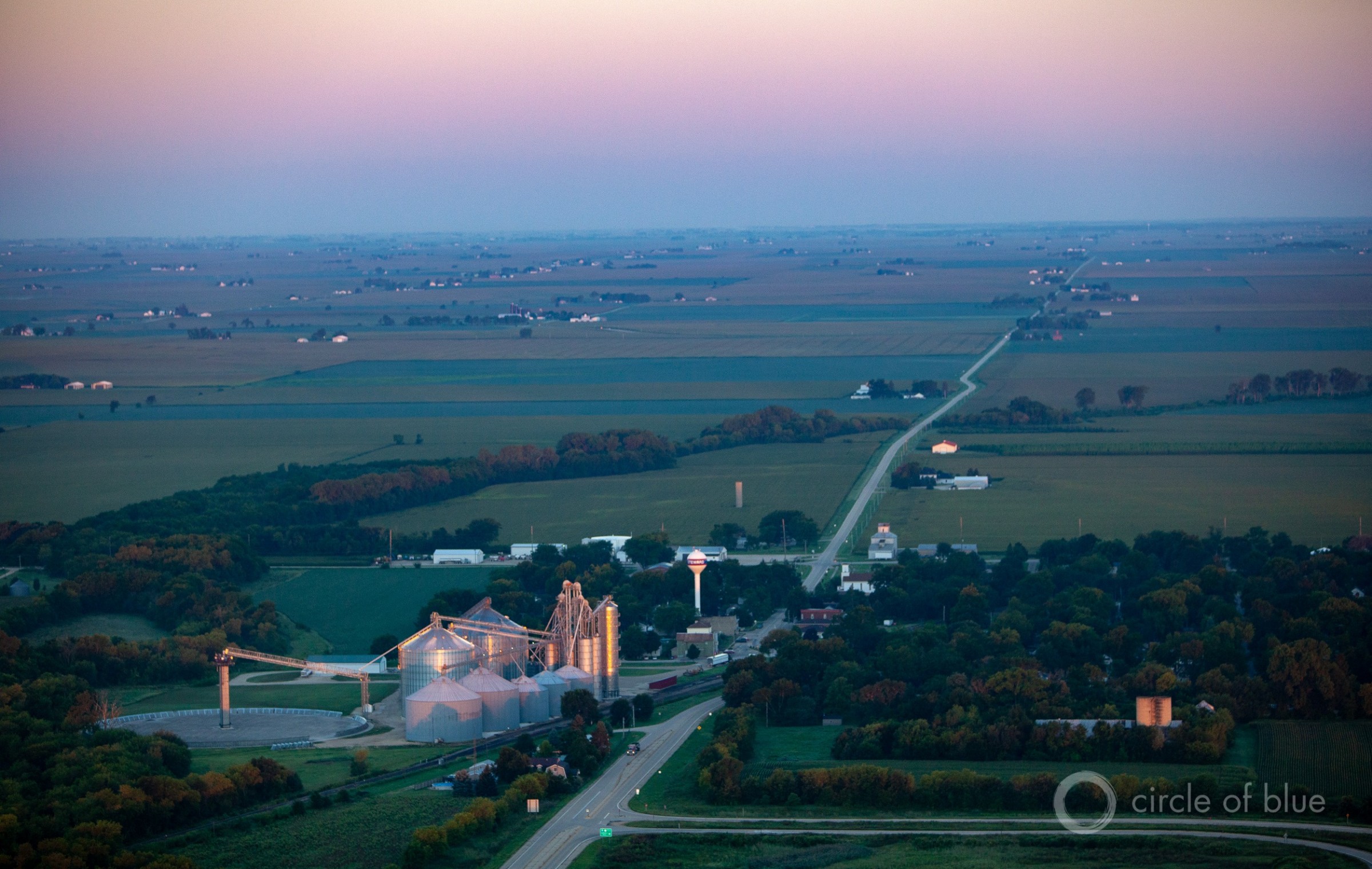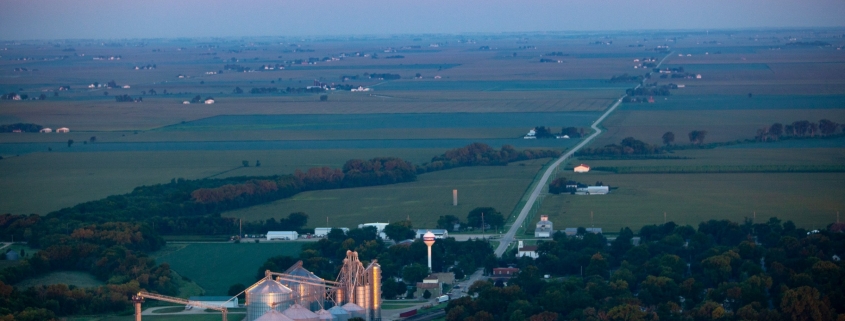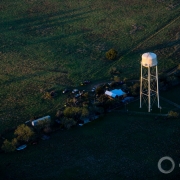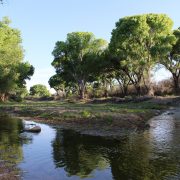‘Make Agribusinesses Pay the Full Costs:’ In Blue New Deal, Warren Targets Farm Pollution, Great Lakes
Freshwater policies included in Warren’s ocean plan.

Illinois fields catch the first rays of daybreak. Runoff from farm fields in the Mississippi River watershed contributes to dead zones in the Gulf of Mexico. Photo © J. Carl Ganter/Circle of Blue
By Brett Walton, Circle of Blue
Elizabeth Warren, a leading contender for the Democratic presidential nomination, called for a Blue New Deal on Tuesday, unveiling her plan to protect the oceans, Great Lakes, and the rivers that flow into them from pollution and overdevelopment.
The policies that Warren outlined are a nod and a counterpart to the Green New Deal, a proposal in Congress to reduce greenhouse gas emissions and transition from a fossil fuel-based economy.
“As we pursue climate justice, we must not lose sight of the 71 percent of our planet covered by the ocean,” states the introduction to Warren’s Blue New Deal. “While the ocean is severely threatened, it can also be a major part of the climate solution — from providing new sources of clean energy to supporting a new future of ocean farming. That is why I believe that a Blue New Deal must be an essential part of any Green New Deal — helping us fight climate change, protecting our health, and creating good, high-wage union jobs in the process.”
Climate change has attained unparalleled prominence in U.S. campaign politics in the run-up to the Democratic primary. All of the leading candidates have released climate plans, some more detailed than others. These plans spell out goals for curbing greenhouse gas emissions as well as how to respond to rising seas and hotter temperatures.
Despite the direct attention to climate, water is a different story. No candidate has a standalone water strategy. When it is mentioned, water is positioned within policy statements on farming, rural economy, climate change, environmental justice, or infrastructure.
Water policy observers nonetheless view Warren’s Blue New Deal and water-related statements from other candidates as significant steps forward in this election cycle.
“We’re thrilled to see that the critical issues of water, equity, and climate are being addressed in bigger ways by Presidential candidates, and hope that this further elevates these issues so that all candidates will put forth their ideas on our water future,” Katherine Baer, director of science and policy for River Network, wrote to Circle of Blue in an email.
Warren’s policy proposals, in general, “have set the bar pretty high” in this primary election, said Sri Vedachalam, director of water at the Environmental Policy Innovation Center. Her detailed plans, numbering more than five dozen, have forced opponents to respond with a level of detail rarely seen in a primary campaign, he said.
“This kind of detail is something you typically see once a president is in office,” Vedachalam told Circle of Blue. He called Warren’s flurry of policy proposals a “new benchmark.”
The bulk of the Blue New Deal’s provisions addresses the oceans, which are gasping in the face of manmade pressures. Overharvesting is depleting fish stocks, and warming waters are holding less oxygen and more carbon. Less oxygen suffocates fish and constricts their habitat, while more carbon is acidifying the waters, to the detriment of coral reefs.
Warren aims to increase the number of marine protection zones and revive storm-buffering mangroves and carbon-sequestering sea grasses. She wants to deploy more offshore wind turbines, ban new offshore oil leases, and electrify port infrastructure.
Freshwater Connections
Though it focuses mostly on oceans, the Blue New Deal also looks upstream, to the rivers and lakes that feed the seas. The concern is what is carried in those waters.
Though city streets and sewers are a conduit for the debris of urban life, Warren’s stated concern is agriculture, the source of pesticides and fertilizers that foul waterways. Fertilizers, in particular, are to blame for the annual low-oxygen “dead zone” in the Gulf of Mexico and harmful algal blooms in Lake Erie.
The Blue New Deal proposes two remedies, neither of which is fully formed, Vedachalam argues. One is to “make agribusiness pay the full cost” of environmental damage by closing loopholes and stepping up enforcement. It’s a line Warren borrows from her plan for a new farm economy. But federal fines are often a “slap on the wrist,” Vedachalam said, and much power is delegated to the states.
Some jurisdictions have successfully protected drinking water sources by collaborating with farmers. Rock County Rural Water District, in southwestern Minnesota, earned national recognition for its groundwater protection program. The district sought conservation easements for farmland around its water supply wells and helped farmers with the cost of planting nutrient-absorbing cover crops. Only 40 feet deep, the shallow wells could be easily contaminated by nitrates.
The other remedy in Warren’s plan is to reinstate an Obama-era rule that defined the waterways that are protected under the Clean Water Act. The Trump administration repealed that rule and intends to replace it with a substantially narrower definition.
But, as Vedachalam pointed out, the Obama administration’s rule was blocked by the courts and was never in effect nationwide. Without some restructuring, it cannot simply be “reinstated,” he said.
Beyond pollution, the Blue New Deal mentions the climate extremes of this era, such as the need for drought planning and the recent water cutbacks in the Colorado River basin.
“As the population continues to grow and development increases in our most drought-prone states, it is important for federal and state governments to encourage responsible and smart growth,” according to the plan.
Smart growth is an aspect of flood preparation, too, and Warren suggests boosting federal buyouts of properties at high risk of flooding.
Warren also notes that she will “fight for a fully funded Great Lakes Restoration Initiative.” Started in 2010, the initiative is the federal government’s foremost investment in a regional ecosystem cleanup, with about $3 billion in funding over a decade.
Securing funding for the initiative may not be much of a fight, Vedachalam said. It is a rare environmental program that enjoys steady and enthusiastic support from Democrats and Republicans. After President Trump suggested cutting funding by 90 percent earlier this year, Congress ended up appropriating the full $300 million.
The initiative “is one of the few bright spots” for environmental politics in Congress, Vedachalam said. Replicating that bipartisan success with other environmental programs is a fruitful place to start.
Brett writes about agriculture, energy, infrastructure, and the politics and economics of water in the United States. He also writes the Federal Water Tap, Circle of Blue’s weekly digest of U.S. government water news. He is the winner of two Society of Environmental Journalists reporting awards, one of the top honors in American environmental journalism: first place for explanatory reporting for a series on septic system pollution in the United States(2016) and third place for beat reporting in a small market (2014). He received the Sierra Club’s Distinguished Service Award in 2018. Brett lives in Seattle, where he hikes the mountains and bakes pies. Contact Brett Walton












Thanks for the post.